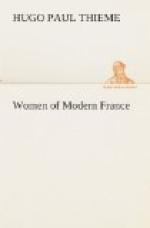These two men—the lover and the husband—carried on with two sisters their licentious living and extravagances to such an extent that the injured wife demanded a separation of her fortune from that of her husband, in which project her father-in-law aided her and gave her thirteen thousand francs income. Mme. d’Epinay, in the midst of success, became acquainted with Mlle. Quinault, the daughter of the famous actor of the time, and herself a great actress. This woman invited Mme. d’Epinay to her so-called salon, which was, possibly, the most licentious and irreligious of the salons then in vogue, where she met Duclos, with whom she immediately formed a strong friendship.
After the death of M. de Bellegarde, her wealth was considerably increased, a piece of good fortune which enabled her to carry out all her plans. It was at this time, 1755, that she induced Rousseau to live in her cottage, “l’Hermitage;” and for about two years she enjoyed perfect happiness with him. By a peculiar freak of fate she fell in with Grimm, who was introduced to her by Rousseau and who had, for some time, been on the hunt for a “faithful mistress.” This German by birth, but Frenchman in spirit, had championed her at a dinner, where she was the object of the severest reproach. She had burned the papers of her sister, Mme. de Jully, who had betrayed an honest husband. Stricken with smallpox, just before dying, she confessed all to Mme. d’Epinay. The latter owed Mme. de Jully fifty ecus and the note was among the papers of Mme. de Jully. Mme. d’Epinay was accused of having burned the note to which it was asserted she had access; and Grimm undertook to plead her cause, an act which so elated madame that she turned all her affection upon her defender, whereupon Rousseau departed. Later on, the note having been found, Mme. d’Epinay was completely vindicated. Grimm then became her third lover.
This third marriage, so to speak, was one of reason; the first was one of mere emancipation; the second, one of passion and genuine love. In 1755, worn out physically, she took a trip to Switzerland, to be treated by the famous Dr. Tronchin; there she became so ill that Grimm was summoned. They remained together for about two years, and after her return to Paris she reopened her salon of “La Chevrette.” Her reunions partook more of the nature of our house parties; the salon was an immense room, in which the members would pair off and divert themselves as they pleased; in that respect “La Chevrette” was unique. After her fortune, which at one time was quite large, became diminished, partly through her own extravagance and partly through that of her son, who was the very counterpart of his father, she was forced to rent “La Chevrette” and, later on, “La Briche,” where she had opened her second salon.
The last years of her life she spent in Paris with Grimm. She had reached such a physical condition that her sufferings could be relieved only by the use of opium. Financial relief came to her in 1783, when the Academy awarded her the Montyon prize, then given for the first time, for her Conversations d’Emilie. She died in the same year, surrounded by her dearest friends—Grimm, M. and Mme. Belgunce, and Mme. d’Houdetot.




